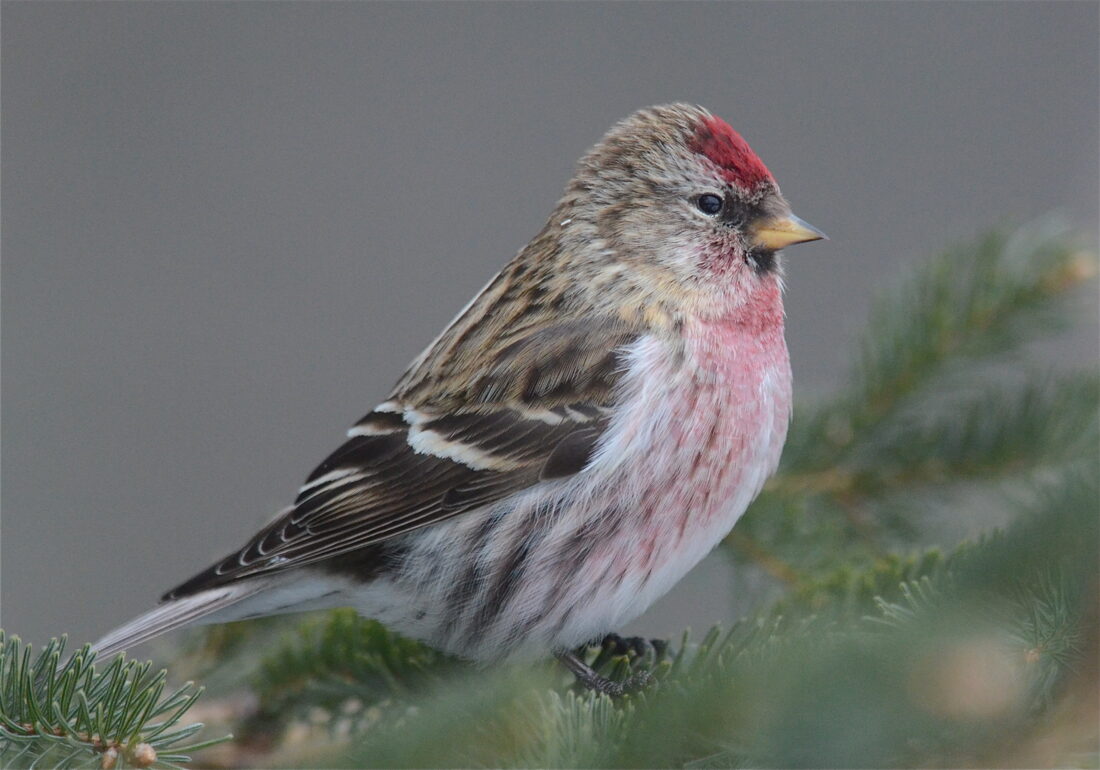What’s Flying: Birds prepare for spring despite winter storm

A common redpoll is shown.. (Scot Stewart photo)
“Life needs to be like a roller-coaster ride with ups and downs. Otherwise, it’s not exciting.” – N. T. Rama Rao, Jr

Feels like the roller coaster just too that big dive and everyone knows the brakes don’t work. In another winter with temperatures going up and down like a kid on a trampoline with the sun and the Colorado lows playing tag, these big storms are just hard on the system.
The Upper Peninsula has regularly warned of its “St. Patrick’s Day Blizzard”. This one appears to be right on the money. Spring here always likes to play games and it has not been clear if the area’s wildlife knew what was coming. The part of spring storms that does make them easier is the warmer weather that follows, often melting a good share of the latest layer of snow. Even the one this week was a bit of a mystery as there were many changes in predicted temperatures and the storm’s track.
Birds do seem to be spending more time lately foraging for more nature foods and spending less time at area feeders. Squirrels, on the other hand seem to be doing just the opposite. At several feeding stations in Marquette, the feeders have maxed out at times with four or five squirrels at the sunflower seeds and suet all at the same time.
Tracking bird migration can be a great way to beat the feelings that might arise from watching a new spring storm. A favorite part, because it is so accessible can be the mapping of ruby-throated hummingbird migration. Hummingbird Central’s map, https://www.hummingbirdcentral.com/hummingbird-migration-spring-2023-map.htm seems to be the first to begin plotting sightings in the southeastern states.
There will be several maps posted on the net, and because they are created through sightings reported to their maps by private citizens, they will vary, particularly along the leading edge as the irregularities in weather, experience and time of volunteers all vary. As of Wednesday, they were being seen as far north as the southern border of Tennessee at multiple sites. While it will still be nearly two months (the first week or so in May) before they hit the Upper Peninsula, it does provide some comfort to see they are moving northward and slowly drawing closer.
There continues to be a few early arrivals of other species at the southern edge of the U.P. as early arrivals slowly this way. Common grackles, red-winged blackbirds and Canada geese continue to inch northward into the area, but with the snow cover still impressive across much of the area, many birds will hold off on moving northward a while longer.
Watching ebird reports for Wisconsin and Illinois will provide a window on migration’s progress. Sporadic reports of horned and pied-billed grebes, sandhill cranes, more blackbirds, scaup, gadwalls, killdeer and northern harriers have all been listed in recent sightings reports from those states this week as the weather there improves, but see saws there too. Small amounts of snow have periodically covered the ground to the south
Part of the delight of spring is finding species from the north like pine grosbeaks, common redpolls and pine siskins. The siskins have been extremely rare in the U.P. this winter. Singles and doubles have been the most common numbers when reporting sightings here this winter. Redpolls have also been seen in very low numbers, so a report of 45 on the Peshekee Grade this week was notable. Pine grosbeaks were common this winter but in the past few weeks their numbers have dropped dramatically so no most reports include just one or two.
Snowy owls continue in the eastern U.P. Four were seen near Rudyard last Saturday, so there are some hanging on there. The snowy owl seen in Marquette on March 4 has not been reported again. The shoreline ice formations near Picnic Rocks have changed dramatically since then and much of that ice is now gone. As the average daily temperatures slowly rise, ice on Lake Superior will continue to shrink offering fewer places for owls to roost if they are hunting ducks and gulls on the Lake.
A small group of bald eagles was seen flying over M-553 between Sands and Marquette recently. They may have been exhibiting some courtship behavior as a single each flew near a pair weaving in braided aerial patterns overhead. Courtship of eagles can become quite dramatic as they can dive, clench each other’s talons and go into a freefall before disengaging. Bald eagles are usually at least four years old before they pair off to mate. They usually have all white heads and tails by that age, but occasionally it takes another year for that to happen. This has been a good winter for watching eagles in the U.P.
Several reports of at least one report of a white-throated sparrow in Delta County and dark-eye juncos have also come in. These birds will definitely do better spending time around area feeders in the northern U.P. as even taller weeds and their seeds are under a layer of snow in most places.
Robins look like they will make it on to spring here as a number of them are still in Marquette. They are still relying on crab apples fruits to tide them over. Birders can aid some early arrivals by keeping feeder full, but insect eaters like wrens, woodcocks, and flycatchers will do well to wait until the area gets a new up in temperatures and a down to the height of the snow drifts still around



